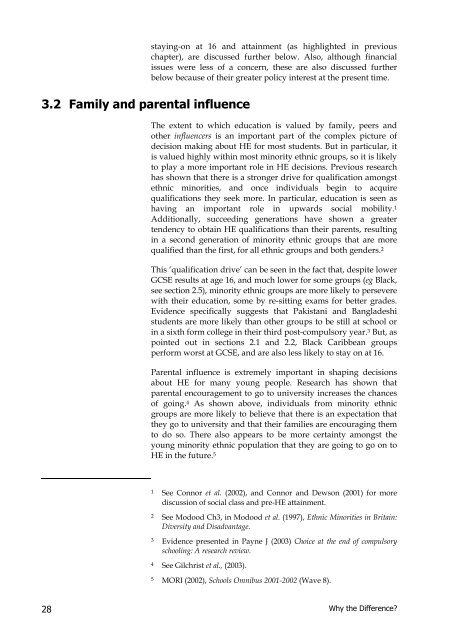A Closer Look at Higher Education Minority Ethnic Students and ...
A Closer Look at Higher Education Minority Ethnic Students and ...
A Closer Look at Higher Education Minority Ethnic Students and ...
Create successful ePaper yourself
Turn your PDF publications into a flip-book with our unique Google optimized e-Paper software.
staying-on <strong>at</strong> 16 <strong>and</strong> <strong>at</strong>tainment (as highlighted in previouschapter), are discussed further below. Also, although financialissues were less of a concern, these are also discussed furtherbelow because of their gre<strong>at</strong>er policy interest <strong>at</strong> the present time.3.2 Family <strong>and</strong> parental influenceThe extent to which educ<strong>at</strong>ion is valued by family, peers <strong>and</strong>other influencers is an important part of the complex picture ofdecision making about HE for most students. But in particular, itis valued highly within most minority ethnic groups, so it is likelyto play a more important role in HE decisions. Previous researchhas shown th<strong>at</strong> there is a stronger drive for qualific<strong>at</strong>ion amongstethnic minorities, <strong>and</strong> once individuals begin to acquirequalific<strong>at</strong>ions they seek more. In particular, educ<strong>at</strong>ion is seen ashaving an important role in upwards social mobility. 1Additionally, succeeding gener<strong>at</strong>ions have shown a gre<strong>at</strong>ertendency to obtain HE qualific<strong>at</strong>ions than their parents, resultingin a second gener<strong>at</strong>ion of minority ethnic groups th<strong>at</strong> are morequalified than the first, for all ethnic groups <strong>and</strong> both genders. 2This ‘qualific<strong>at</strong>ion drive’ can be seen in the fact th<strong>at</strong>, despite lowerGCSE results <strong>at</strong> age 16, <strong>and</strong> much lower for some groups (eg Black,see section 2.5), minority ethnic groups are more likely to perseverewith their educ<strong>at</strong>ion, some by re-sitting exams for better grades.Evidence specifically suggests th<strong>at</strong> Pakistani <strong>and</strong> Bangladeshistudents are more likely than other groups to be still <strong>at</strong> school orin a sixth form college in their third post-compulsory year. 3 But, aspointed out in sections 2.1 <strong>and</strong> 2.2, Black Caribbean groupsperform worst <strong>at</strong> GCSE, <strong>and</strong> are also less likely to stay on <strong>at</strong> 16.Parental influence is extremely important in shaping decisionsabout HE for many young people. Research has shown th<strong>at</strong>parental encouragement to go to university increases the chancesof going. 4 As shown above, individuals from minority ethnicgroups are more likely to believe th<strong>at</strong> there is an expect<strong>at</strong>ion th<strong>at</strong>they go to university <strong>and</strong> th<strong>at</strong> their families are encouraging themto do so. There also appears to be more certainty amongst theyoung minority ethnic popul<strong>at</strong>ion th<strong>at</strong> they are going to go on toHE in the future. 51 See Connor et al. (2002), <strong>and</strong> Connor <strong>and</strong> Dewson (2001) for morediscussion of social class <strong>and</strong> pre-HE <strong>at</strong>tainment.2 See Modood Ch3, in Modood et al. (1997), <strong>Ethnic</strong> Minorities in Britain:Diversity <strong>and</strong> Disadvantage.3 Evidence presented in Payne J (2003) Choice <strong>at</strong> the end of compulsoryschooling: A research review.4 See Gilchrist et al., (2003).5 MORI (2002), Schools Omnibus 2001-2002 (Wave 8).28Why the Difference?
















